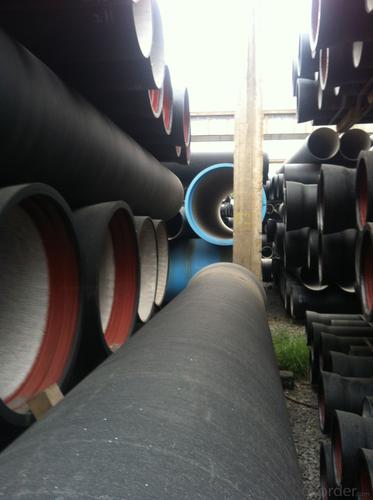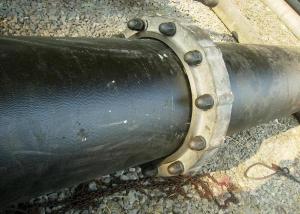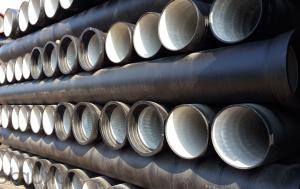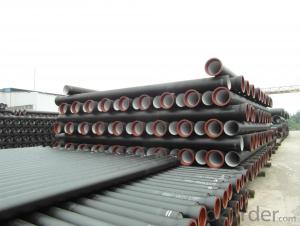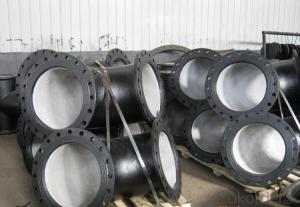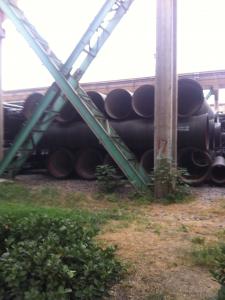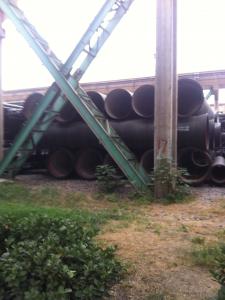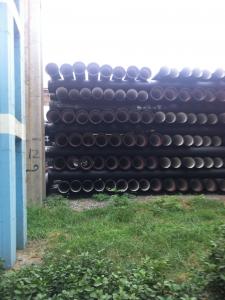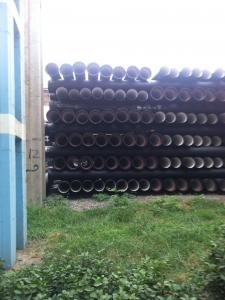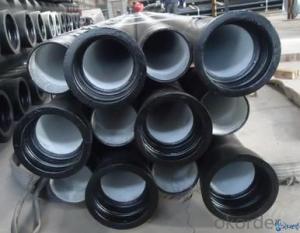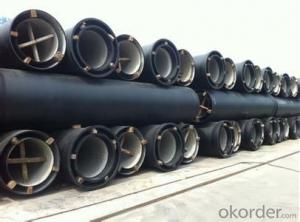DUCTILE IRON PIPES AND PIPE FITTINGS K9 CLASS DN200
- Loading Port:
- Tianjin
- Payment Terms:
- TT OR LC
- Min Order Qty:
- 22 pc
- Supply Capability:
- 3000 pc/month
OKorder Service Pledge
OKorder Financial Service
You Might Also Like
Material : Ductile Cast Iron
Size Range : DN 80mm to DN 2000mm
Unit Effective Length : 6m or 5.7m
Manufacture Standard: ISO 2531:1998/ EN 545:2006/EN 598:2007
Annual capacity : 200,000 tons
Coating Exterior: Zinc 130g/m2 according to ISO 8179-1 and bitumen coating 70 microns.
Cement Interior: Portland Cement/ High Alumina Cement/ Sulphate Resisting Cement Lining according to ISO 4179
Special requirements on external coating and internal lining can be applied
We also provide accessories such as SBR/EPDM rubber gaskets, lubricant paste, pipe caps, PE sleeves, etc.
Additional Parts:
Each pipe is strictly inspected according to related standard to ensure permanently high performance.
Easy Installation at site and service free for life
Long Service Lifespan
Quotation will arrive you within 24hours once we get your inquiry.
We guarantee offering you a competitive price.
A copy of original inspection reports of pipes will be offered after shipment.
Photos of loading process will be sent to the customer after shipment effect.
We will follow-up the delivery progress after shipment effect and update to the customer on weekly basis.
- Q: Can ductile iron pipes be used for mining applications?
- Yes, ductile iron pipes can be used for mining applications. Ductile iron pipes are known for their strength, durability, and resistance to corrosion, making them suitable for various industrial purposes, including mining. Their ability to withstand high pressure and handle heavy loads makes them ideal for transporting water, slurry, and other materials commonly used in mining operations. Additionally, ductile iron pipes have a long lifespan, reducing the need for frequent replacements and maintenance in mining environments.
- Q: How are ductile iron pipes installed?
- Ductile iron pipes are typically installed using the following method. First, the trench is excavated to the required depth and width. The bottom of the trench is then carefully leveled and compacted to provide a stable foundation. Next, a bedding material, usually a sand and gravel mixture, is placed at the bottom of the trench. This bedding material helps to support the pipe and distribute the load evenly. It also serves to protect the pipe from any sharp objects that may be present in the soil. Once the bedding is prepared, the ductile iron pipes are carefully lowered into the trench and aligned to the desired position. It is important to ensure that the pipes are properly aligned and have the correct slope for efficient water flow. After the pipes are in place, they are joined together using a mechanical joint or a push-on joint system. These joints are designed to provide a secure and leak-free connection between the pipes. The joints are typically sealed using rubber gaskets, which help to create a watertight seal. Once the pipes are joined, the trench is backfilled with the excavated soil, taking care to compact it in layers to prevent settlement. The backfilling process is usually done in stages to allow for proper compaction. Finally, the installation is completed by connecting the ductile iron pipes to the existing water supply system or other pipes using appropriate fittings and valves. Pressure testing may also be carried out to ensure the integrity of the installation. Overall, the installation of ductile iron pipes requires careful planning, proper alignment, and secure jointing to ensure a long-lasting and reliable water supply system.
- Q: How are ductile iron pipes protected against freeze-thaw cycles?
- Ductile iron pipes are protected against freeze-thaw cycles through several measures. Firstly, the material used in ductile iron pipes is inherently resistant to low temperatures and can withstand freezing conditions without becoming brittle or prone to cracking. Additionally, the pipes are often coated with a protective layer, such as cement mortar lining or polyethylene encasement, to provide an extra barrier against freeze-thaw damage. These coatings serve to insulate the pipe and prevent direct contact between the iron and the surrounding environment. Furthermore, ductile iron pipes are commonly designed with joints that allow for movement and flexibility, which helps to accommodate any expansion or contraction that may occur during freeze-thaw cycles. This flexibility reduces the risk of pipe breakage or damage due to the pressure exerted by freezing water inside the pipe. Moreover, proper installation practices, including adequate bedding and backfilling, are crucial in protecting ductile iron pipes against freeze-thaw cycles. Ensuring that the pipes are properly supported and surrounded by suitable materials helps to minimize the impact of freezing temperatures on the structural integrity of the pipes. Regular inspection and maintenance of ductile iron pipes are also essential in identifying any potential issues caused by freeze-thaw cycles. Periodic assessments can help detect any signs of damage or deterioration, enabling timely repairs or replacement to prevent further damage. In summary, ductile iron pipes are protected against freeze-thaw cycles through the inherent resistance of the material, protective coatings, flexible joints, proper installation practices, and regular maintenance. These measures collectively contribute to the durability and longevity of ductile iron pipes, even in cold weather conditions.
- Q: Can ductile iron pipes be used in areas with high levels of hydrogen sulfide gas?
- Yes, ductile iron pipes can be used in areas with high levels of hydrogen sulfide gas. Ductile iron pipes have a high corrosion resistance, which makes them suitable for such environments. Additionally, they have been successfully used in sewage systems and wastewater treatment plants where hydrogen sulfide gas is commonly present.
- Q: How do ductile iron pipes handle soil movement?
- Ductile iron pipes are known for their excellent strength and durability, making them highly capable of handling soil movement. These pipes are designed to resist external loads and pressures caused by soil settlement, ground shifting, or other environmental factors. One of the key features of ductile iron pipes is their flexibility. Unlike rigid materials such as cast iron or concrete pipes, ductile iron pipes have a certain level of elasticity that allows them to withstand soil movement without cracking or breaking. This flexibility enables the pipes to absorb the stresses induced by the soil, preventing any significant damage to the pipeline system. Furthermore, ductile iron pipes possess high tensile strength, which means they can resist pulling forces resulting from soil movement. The pipes can withstand the expansion and contraction of the surrounding soil, reducing the risk of pipe deformation or failure. Moreover, ductile iron pipes are often installed with proper bedding and backfilling techniques to further enhance their ability to handle soil movement. Adequate bedding materials, such as crushed stone or sand, are used to provide stable support to the pipes and distribute the external loads evenly. This helps to minimize the impact of soil movement on the pipes and maintain their structural integrity. In summary, ductile iron pipes are designed to effectively handle soil movement due to their flexibility, high tensile strength, and proper installation methods. These pipes can withstand the stresses induced by soil settlement, ground shifting, or other soil-related factors, ensuring reliable and long-lasting performance in various environmental conditions.
- Q: Can ductile iron pipes be used for bridge drainage systems?
- Yes, ductile iron pipes can be used for bridge drainage systems. Ductile iron pipes are known for their strength, durability, and resistance to corrosion, making them suitable for various applications, including bridge drainage systems. They can effectively handle the flow of water and withstand the weight and pressure of vehicles passing over the bridge.
- Q: What is the expected pressure rating of ductile iron pipes?
- The expected pressure rating of ductile iron pipes generally varies depending on the specific size, thickness, and application requirements. However, ductile iron pipes are known for their high strength and durability, allowing them to withstand high-pressure situations. Typically, they can handle working pressures ranging from 150 to 350 psi (pounds per square inch) or even higher, making them suitable for various water supply, wastewater, and industrial applications.
- Q: What is the K9 standard pressure for ductile iron pipes?
- Ductile weakness: ductile cast iron pipes connected by human factors such as the operation level of responsibility, influence, construction not convenient. The advantages of PE PE PE pipe has good corrosion resistance and its anti inorganic performance than that of the metal pipe is much stronger in the buried without corrosion, construction convenient. Small diameter PE pipe in the price performance ratio is better than that of steel and ductile iron.PE tube have disadvantages: benzene, gasoline, carbon tetrachloride and other organic solvents have certain effect on pe. If the organic solvent is infiltrated into the polyethylene, the swelling will occur, and its physical properties will be decreased. Its pressure resistance and temperature resistance are poor.
- Q: Can ductile iron pipes be recycled?
- Yes, ductile iron pipes can be recycled. Ductile iron is a type of cast iron that has superior strength and durability, making it a popular choice for various applications, including water and sewage pipelines. When these pipes reach the end of their useful life, they can be recycled and used to manufacture new products. The recycling process involves melting down the ductile iron pipes to extract the iron, which can then be used as a raw material for producing new ductile iron products. Recycling ductile iron pipes not only helps conserve natural resources but also reduces the environmental impact associated with mining and manufacturing new materials.
- Q: What is the cost of ductile iron pipe compared to other pipe materials?
- The cost of ductile iron pipe is generally higher compared to other pipe materials such as PVC or steel due to its superior durability and strength.
Send your message to us
DUCTILE IRON PIPES AND PIPE FITTINGS K9 CLASS DN200
- Loading Port:
- Tianjin
- Payment Terms:
- TT OR LC
- Min Order Qty:
- 22 pc
- Supply Capability:
- 3000 pc/month
OKorder Service Pledge
OKorder Financial Service
Similar products
Hot products
Hot Searches
Related keywords

